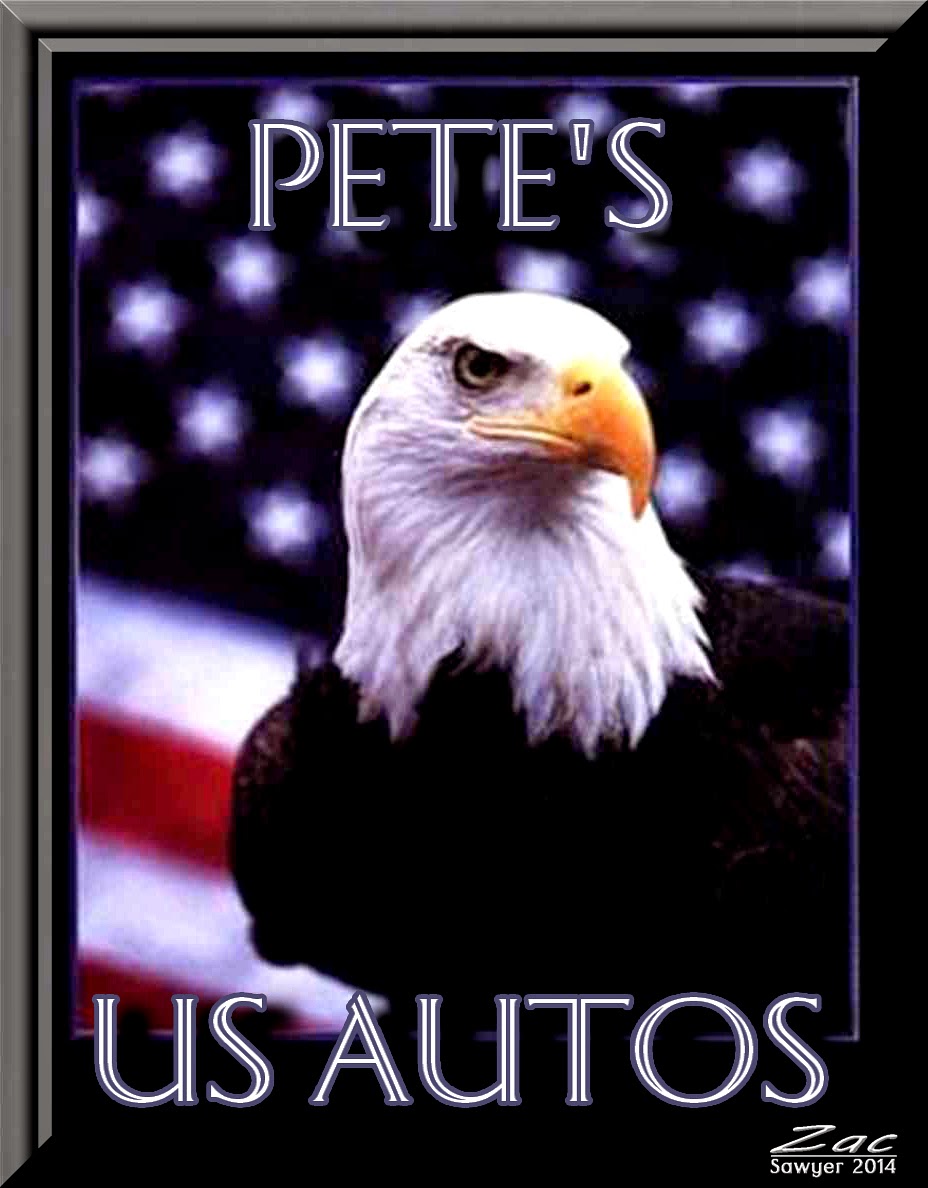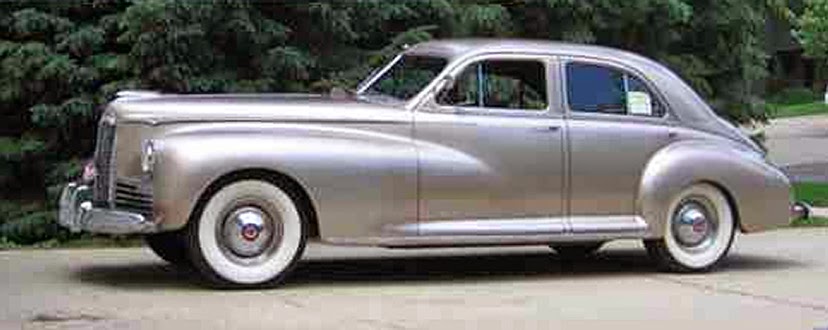 |
| © Copyright Zac Sawyer 201 |
 |
| © Copyright Zac Sawyer 2014 |
US car production was dealt a setback because of World War II.
In 1940 pre World War II the US produced 4,680,000 cars.
Although each decade in history is different - the decade of the 1940's is by far the most unusual in U.S. auto-mobile history.
This was the only period of time when auto-mobile production stopped for a period of 3-4 years.
No cars were manufactured after 1942 due to the advent of World War II.
Production for civilians did not resume until 1946 .
Early 1940's saw the first time luxury cars started rolling off a production line.
A car showed the wealth and status of its owner.
The new 1940s cars had a lower, longer, broader, and more massive look.
Hudson offered a combination automatic clutch with a semi-automatic transmission.
The driver could select either the manual or semi-automatic shift with buttons on the dash
The 1941-42 Packard 'Clipper' was another luxury car produced before the war.
A new car back in 1940s was about $800 and for 18 cents, you could buy a gallon of gas. On average most 1940s cars got about 15 to 20 miles per gallon.
The Packard 'Clipper' was initially a single model of the Packard Motor Car Company introduced in April, 1941. The 'Clipper' name alone was reintroduced in 1953 for the Company's bottom line through 1956, in which final year it was considered a standalone make, and not a model of Packard, similar to the Mercury line of the then Lincoln-Mercury Division of Ford Motor Company.
The Clipper should be remembered as automotive history's most successful committee design, because assigning the genius of its beautiful lines exclusively to one particular designer cannot now be done with any degree of certainty." And as it turned out, this new look guaranteed the Clipper an appearance never compromised by competitive imitators. In 1942 Cadillac and Buick adopted the same pontoon fender line, but the Clipper still looked unique, apart from and slightly above the crowd, especially the new 1942 senior Clippers, which alone retained the début 1941's 127-inch (3,200 mm) wheelbase, longer hood and front fenders.
In 1941 the Chrysler Company started production of the luxury oriented 'Town and Country' wagon.
The 'Town and Country Wagon' featured an optional 9 passenger seating, a rear hatch,and was the first to include genuine wood exterior panels.
The 'Town and Country Wagon' was the original "woody".
This car made a huge splash with the public especially during the immediate postwar era.
The Chrysler Town & Country was a station wagon manufactured by Chrysler Corporation and sold under its flagship brand from 1941–1988.
The model was also sold as a sedan, coupé, and convertible from 1947–1950 and as a convertible again from 1983–1986.
The Town & Country was a début of the first woodie wagon, with an all-steel roof; the roof used was that of the big Chrysler Imperial 8-passenger sedan and limousine, which led to a unique (and compromised) rear loading arrangement, with wood double doors that opened out from the centre beneath a fixed rear window. Production of the cars stopped during World War II. In 1941 and 1942, fewer than 1,000 were manufactured.
General Motors claims the distinction of mass-producing the first pillarless hardtop coupés in 1949; however Chrysler built seven Town and Country versions of this body style in 1946,
After the war the Town & Country nameplate returned, but the station wagon body did not. Town & Country sedans, coupés, and convertibles were also produced from 1946 to 1950 in much larger numbers than the pre-war wagon. Production of the original, woodie Town & Country ended in 1950.
The popular convertible version hit the highways in 1949 with a starting price of $3,970.
The 1940 Chrysler 'Saratoga': along with other Chrysler cars, adopted the new sealed beam headlights, which gave over 50% more light in high beam.
During the middle of the 1940, a special model called the 'Highlander' was introduced as a closed coupé and convertible.
It had authentic Scotch plaid and moleskin leather upholstery.
The 'Saratoga' was introduced as a performance version of the 'New Yorker'
The Ford Motor Company produced a number of 1940s cars like the v-8 deluxe coupé that went for the price of about $650 .
The ford V8 deluxe four door Sedan which went for around $750 , included and were fitted with sealed beam head lights on the deluxe models, and had chrome headlight trim rings, and parking lights.
The new 1940s cars had a lower, longer, broader, and more massive look.
Hudson offered a combination automatic clutch with a semi-automatic transmission.
The driver could select either the manual or semi-automatic shift with buttons on the dash
 |
| © Copyright Zac Sawyer 201 1940 Oldsmobile |
 |
| Ransom E. Olds |
Oldsmobile was a brand of American auto-mobiles produced for most of its existence by General Motors.
Olds Motor Vehicle Co. was founded by Ransom E. Olds in 1897.
In its 107-year history, it produced 35.2 million cars, including at least 14 million built at its Lansing, Michigan factory.
When it was phased out in 2004, Oldsmobile was the oldest surviving American auto-mobile marque, and one of the oldest in the world, after Daimler, Peugeot and Tatra.
In 1901, the company produced 425 cars, making it the first high-volume gasoline-powered auto-mobile manufacturer.
In 1901, the company produced 425 cars, making it the first high-volume gasoline-powered auto-mobile manufacturer.
Oldsmobile became the top selling car company in the United States for a few years. Ransom Olds left the company in 1904 because of a dispute, and formed the REO Motor Car Company. The last Curved Dash Oldsmobile was made in 1907.
General Motors purchased the company in 1908.
The 1901 to 1904 Oldsmobile Curved Dash was the first mass-produced car, made from the first automotive assembly line, an invention that is often mis-credited to Henry Ford and the Ford Motor Company.
After Olds merged Olds Motor Vehicle Co. with the Olds Gas Engine Works in 1899, it was renamed 'Olds Motor Works' and moved to a new plant in Detroit.
By March 1901, the company had a whole line of models ready for mass production.
Unfortunately, a mistake by a worker caused the factory to catch fire, and it burned to the ground, with all of the prototypes destroyed.
The only car that survived the fire was a Curved Dash prototype, which was wheeled out of the factory by two workers while escaping the fire.
A new factory was built, and production of the Curved Dash commenced.
Officially, the cars were called "Olds auto-mobiles," but were colloquially referred to as "Oldsmobiles."
It was this moniker, as applied especially to the Curved Dash Olds, that was popularized in the lyrics and title of the 1905 hit song "In My Merry Oldsmobile."
The 1941-42 Packard 'Clipper' was another luxury car produced before the war.
A new car back in 1940s was about $800 and for 18 cents, you could buy a gallon of gas. On average most 1940s cars got about 15 to 20 miles per gallon.
 |
| 1941-42 Packard 'Clipper' |
The Clipper should be remembered as automotive history's most successful committee design, because assigning the genius of its beautiful lines exclusively to one particular designer cannot now be done with any degree of certainty." And as it turned out, this new look guaranteed the Clipper an appearance never compromised by competitive imitators. In 1942 Cadillac and Buick adopted the same pontoon fender line, but the Clipper still looked unique, apart from and slightly above the crowd, especially the new 1942 senior Clippers, which alone retained the début 1941's 127-inch (3,200 mm) wheelbase, longer hood and front fenders.
In 1941 the Chrysler Company started production of the luxury oriented 'Town and Country' wagon.
The 'Town and Country Wagon' was the original "woody".
This car made a huge splash with the public especially during the immediate postwar era.
 |
| Chrysler Town & Country |
The model was also sold as a sedan, coupé, and convertible from 1947–1950 and as a convertible again from 1983–1986.
The Town & Country was a début of the first woodie wagon, with an all-steel roof; the roof used was that of the big Chrysler Imperial 8-passenger sedan and limousine, which led to a unique (and compromised) rear loading arrangement, with wood double doors that opened out from the centre beneath a fixed rear window. Production of the cars stopped during World War II. In 1941 and 1942, fewer than 1,000 were manufactured.
 |
| Chrysler Town & Country - Interior |
After the war the Town & Country nameplate returned, but the station wagon body did not. Town & Country sedans, coupés, and convertibles were also produced from 1946 to 1950 in much larger numbers than the pre-war wagon. Production of the original, woodie Town & Country ended in 1950.
The popular convertible version hit the highways in 1949 with a starting price of $3,970.
The 1940 Chrysler 'Saratoga': along with other Chrysler cars, adopted the new sealed beam headlights, which gave over 50% more light in high beam.
During the middle of the 1940, a special model called the 'Highlander' was introduced as a closed coupé and convertible.
It had authentic Scotch plaid and moleskin leather upholstery.
The 'Saratoga' was introduced as a performance version of the 'New Yorker'
The Ford Motor Company produced a number of 1940s cars like the v-8 deluxe coupé that went for the price of about $650 .
The ford V8 deluxe four door Sedan which went for around $750 , included and were fitted with sealed beam head lights on the deluxe models, and had chrome headlight trim rings, and parking lights.




No comments:
Post a Comment